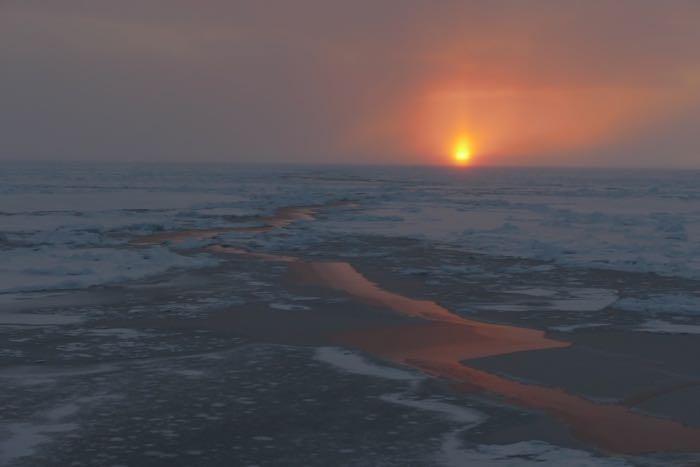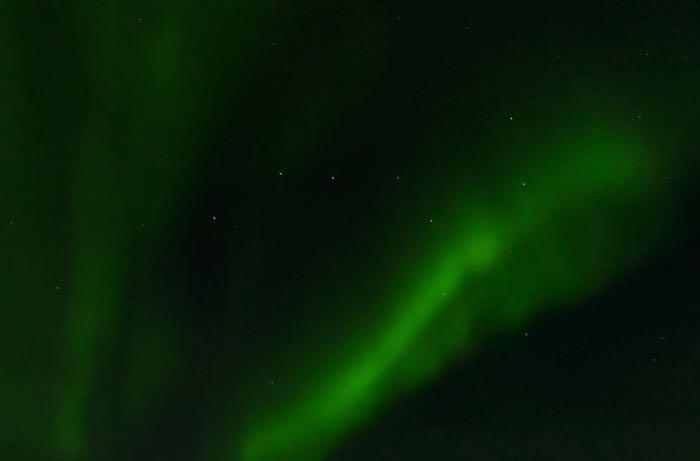Polar Night Eve
This morning, the sun rose here at latitude 85 degrees north for the last time this year. For the rest of 2019 and into February 2020 there will be no direct sunlight. The sun will not rise above the horizon for about 4 months. This is the Polar Night. For the next two weeks, we will still have twilight and a sort of almost sunrise/set for a few hours in the middle of the day. By October 24, even twilight will disappear. Then true darkness will envelope this place, except when skies are clear and the moon is bright.

This causes a lot of challenges for the researchers working in this place. Even now, our daylight for setting up equipment on the ice decreases dramatically every day that goes by. When we set up the first L-site of the distributed network 4 days ago, there was about 12 hours of time that was bright enough to work safely in. This includes true daylight as well as some twilight that is still bright enough to work safely in. Today, we had about 4 hours of daylight and 5-6 additional hours of bright twilight. Tomorrow, perhaps a little more than 5 hours of twilight that is workable.
At the ice camp around Polarstern, they will set up electrical lines and lights to keep the scientists well illuminated while they are working on the ice. For the distributed network efforts based from the Fedorov, we are not equipped to do this. So we'll work fast, bring headlamps, and finish up work whenever the polar bear guards decide they can't see far enough to protect us.
Another challenge for scientists that study living organisms is that the Polar Night is really important to the ecology of Arctic organisms. MOSAiC presents an amazing opportunity to study how organisms behave and survive through the cold and dark of the Arctic winter. However, any light introduced by the ship or the scientists on the ice could impact the behavior and physiology of everything from bacteria to fish. So it is critical that they keep their study zone 'in the dark.' To do this, they actually will set up a dark area about 700 meters (1/2 mile) from the ship. Researchers working there will only use red light headlamps so as not to shine any white light in the ecosystem. Since this is outside the 'protected area' around the ship, they will also have to serve as their own polar bear guards. They'll have to be extra careful, since the red light won't allow them to see very far.
Beyond the scientific work, many people have a difficult time with the lack of daylight. This can lead to personal discomfort and strain mental health. When the daylight decreases back home, I always find myself slowing down a bit. After the fast pace of a light-filled summer, I enjoy the excuse to sleep in a little longer and cozy up early at night. Here on the Fedorov, on days when I don't get out on the ice, afternoon naps are an inviting option. This is all okay. But I know for others the decrease in daylight can cause serious challenges like Seasonal Affective Disorder (SAD).
There are plenty of people around the Arctic that live with this dark season every year. But this far north, it lasts weeks longer. And life on an icebreaker frozen in the sea ice can bring a strange blend of isolation and lack of true alone time. Many of the researchers and crew have not spent this much time in the darkness of a northern winter, so they also don't know exactly how they will react to it all.
To help cope with this, many who will be staying on Polarstern through December or later have brought full-spectrum happy lights with them. Others have lots of vitamin D tablets to replace what they won't be receiving from the sun. The crew will set up a small recreation area on the ice floe where people can walk, ski, and snowshoe. This will give everyone a chance to get some fresh air and exercise. Some people will do most of their work on the ship, so being able to go on the ice for recreation will likely be very important to them. It will also provide a chance for some solo time. Well, almost solo time; the bear guards will always be watching, of course.
When the weather is clear, people on the Polarstern will be able to enjoy moonlight at any hour of the day or night. Moonlight can be quite strong when it reflects and glitters off the snow and ice. And the stars will probably be incredible! This far north, the Aurora Borealis are a bit less common. But I hope they get a few nice shows. I wish them all the best!

Word of the Day
Can you guess what polyarnaya noch refers to? Yes – the Russian word of the day today was for Polar Night. I guess from now on I’ll have to call this section word of the night since we technically won’t have daz.
Education Extension
Seasonal cycles like changes in daylight always remind me of how our own behavior and survival is linked to the lands and waters around us. Sometimes these connections don't feel very clear, but waning light in winter is a good opportunity to remember and reflect on these connections. One activity that can be powerful if facilitated well is a Human-EcosystemAn ecological community together with its environment, functioning as a unit. Calendar. Invite an Elder or other community member to discuss ways that people locally use plants, animals, and other parts of the ecosystem. Talk about what seasonal traditions existed in the past and what happens today in the present. You may also choose to have your students learn from books or an ethnobotany walk, but inviting people from the community to share their own knowledge and experience is invaluable.
Discuss the month or season names in local cultures if you know these words or phrases and it is appropriate to share. These months and seasons may not line up directly with the Western understanding of a calendar, but they shed light on human interactions with the natural world. Use this as a talking point to discuss how seasonal changes in plants, animals, and environment often determine human patterns over time. Ask students to think about how they, and others in the community, rely on seasonal patterns of the natural world. How do they interact with and depend on the land and water and living things at different times of year? Encourage students to think not only about food resources, but also recreational uses, aesthetic and cultural values, and commercial harvesting. List these ideas next to the local month names. Discuss parallels and differences.
Provide each student with paper, colored pencils, rulers, etc. Explain that they are going to make a human-use calendar. In addition to the usual grid of days on the bottom, each calendar page should also include a local traditional name for the month (if possible) and a unique name created by the student to reflect their own and community reliance on resources of that month. Students should also create an illustration at the top of each calendar page to reflect on or both of the names. For example, April might be “First Greens,” June might be “Salmon BBQ Month,” and December might be “Sledding Party.” Provide class time for students to work on their calendars, and encourage them to continue work outside of class, discussing the seasonal traditions and patterns with family, friends, and neighbors. Have students present at least one month of their calendars to each other.
A good structured lesson plan for a Human-EcosystemAn ecological community together with its environment, functioning as a unit. Calendar is available through the Alaska Oil Spil Curriculum from the Prince William Sound Regional Citizens' Advisory Council. Once you have navigated to their site, find the tab for education resources, click on the link for the Alaska Oil Spill Curriculum, and then look for Human-EcosystemAn ecological community together with its environment, functioning as a unit. Calendar in 5-6th grade band.


Comments